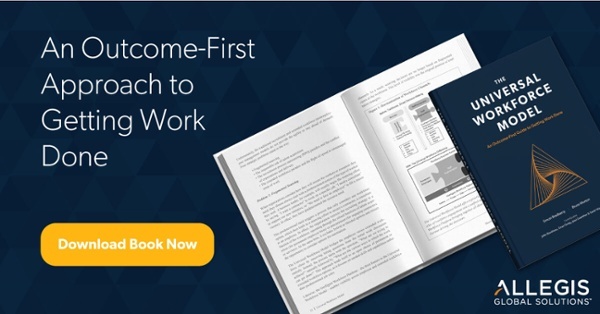Transforming Workforce Recruitment with Harmonisation of Channels
In this ever-evolving workforce landscape, business leaders are searching for ways to build a sustainable workforce recruitment model to help them compete for talent and ensure their goals are met. Establishing a skills-based workforce recruitment model is often acknowledged as an ideal and highly effective answer to many workforce acquisition challenges. However, without a widely recognised and urgent business need, it can be daunting for C-suite and other executive leaders to decide to transform their talent acquisition methods from traditional practices, which often include hiring based on previous experience alone. In addition to this, current workforce acquisition practices are often supported by separate and completely different processes depending on the worker category, meaning business leaders are required to make a decision about how they want to hire before they have sight of or are able to understand market conditions and what their options may be to get the work completed.
Despite some reluctance to change, more and more company leaders are embracing modern workforce recruitment models. These strategies can help leaders potentially future-proof their workforce plan and engage new generations of workers. Modern plans emphasise a skills-based approach, total workforce visibility and building more harmonisation between sourcing channels.
What is a Skills-Based Workforce Recruitment Model?
In a skills-based organisation, workforce acquisition is not only about filling vacancies, but also about building a diverse, agile and adaptable workforce that can respond to changing demands and opportunities. A skills-based organisation recognises that skills are the most valuable asset of its people, and that skills can be acquired, developed and transferred across different roles, projects and domains. A skills-based organisation also leverages technology, data and analytics to assess, measure and match the skills of its workforce with the skills of its business needs.
A skills-based workforce acquisition model focuses on establishing the skills requirements and expectations for the work demand that they are trying to fulfill and then assessing candidates from across all worker categories accordingly. Once these skills are determined, candidates’ skills rather than their experience are matched to the tasks that need to be completed.
This is highly effective in expanding the talent pool and increasing the diversity of candidates, by creating opportunities for individuals who may not have the conventional qualifications or experience but have the relevant skills for the job. It enables the organisation to access a wider and deeper pool of talent, as it can source workers from different geographies, sectors and backgrounds, based on their skills and potential rather than their credentials and experience. For example, instead of looking specially for a candidate that has previously navigated their way to Edinburgh, which may yield 10 people; you look for candidates who can read a map, yielding 100 people.
It also allows organisations to decrease bias and subjectivity in their workforce acquisition process, by using a common and objective language and criteria to evaluate and compare candidates' skills, rather than relying on subjective perception or preferences.
A skills-based approach allows an organisation to adapt to changing business needs and opportunities, as it can quickly and flexibly deploy workers with the right skills to the right tasks, projects and roles, without being constrained by rigid job descriptions and organisational structures.
Organisations also see an improvement in job performance, by matching candidates' skills to the actual tasks and expectations of the job rather than assuming that experience means competence.
The open visibility of all channels allows for a more centralized management of your workforce hiring practices. A workforce business partner, who advises the organisation’s leadership on the most appropriate workforce options, determines which roles should be filled from which silo of talent based on the skills required, spend, goals, etc. The workforce business partner is supported by the workforce acquisitions manager, who executes the plan and has the ability to source talent from all previously siloed channels – full-time employees (FTE), contingent workers, consultants/SOW and automation/AI – without restrictions or hindrances.
Workforce solutions would no longer be divided into recruitment processing outsourcing (RPO) or managed service provider (MSP) programmes but instead, act as a means of acquiring talent with the skills and knowledge needed for greater productivity.
Utilising technology to provide a complete view of the entire workforce – as well as the skills required for the role – managers and workforce business partners can assess the internal workforce, spend limits, external worker options and more to determine the most cost-effective and efficient way to get that job done.
How Harmonisation of Source Channels Brings Companies Closer to Reaching Their Goals
The harmonisation of workforce acquisition channels, such as internal, external, permanent, contingent, and statement of work means that organisations can access and manage any type of talent through a single point of entry and a common skills framework, rather than having separate processes and systems for different categories of workers. This is intended to simplify the process and optimise the outcomes, as well as create a more consistent and inclusive experience for all workers.
In traditional hiring and sourcing practices, the decision to either hire an FTE, contingent worker or a consultant is decided first – often based on what has been done in the past. However, this workforce management approach does not take into consideration if past choices are still the best choices for the organisation’s current needs.
Often, this siloed approach ignores other options that may better serve the business. Whereas a harmonised approach allows decision-makers to review the entire workforce and determine which channel best serves the job and subsequently drives productivity.
For example, if a company needs a project manager for a limited time, it seems logical to hire a consultant and begin the process of creating an SOW. However, a deeper look at the current FTEs may reveal an underutilised employee with project management skills that could be brought onto the project for less than half the cost of the consultant. As well as saving money, this reach across the silos may invigorate and properly challenge a potentially dissatisfied employee, showing them that they are valued and building loyalty. Other internal options could include:
- Upskilling – Increasing skills training for current workers related to their role to include much-needed skills for the business
- Reskilling – Engaging employees with training of new skills unrelated to their current roles, for use in other work the business requires
- Lateral Promoting – Promoting within the organization to similar roles in different departments or combining the role to serve both departments
This process of changing to a skills-based approach and opening your workforce management view to include all sourcing channels can seem daunting. Allegis Global Solutions (AGS) detailed the process in our book on the Universal Workforce Model™, which also acknowledges that the approach needs to be tailored to the unique needs and structure of your business. Many of the ideas are logical next steps to maintain a competitive edge in your market and ride out the ever-shifting talent landscape as your business grows and evolves.
How Full Workforce Visibility Impacts the Health of the Entire Organisation
In addition to revealing cost-saving opportunities, a workforce management style that allows decision-makers a holistic view of the entire workforce creates opportunities for increasing workforce utilisation, discovering talent gaps and assessing new channels that may not have been considered in the past.
Increase Workforce Utilisation
When you are assessing your entire workforce and able to review not just FTEs but the extended workforce, this makes it easier to see where individuals, or entire teams, are underutilised and could use bigger challenges. It also makes it possible to determine which resources could be put to better use in other parts of the company or even within the same department.
Increasing workforce efficiencies can be even more crucial on a global scale. For example, if you have five people working on the same software update and they’re only using a portion of their work hours, some of those workers could be better utilised on other projects. Increase their lost work hours across five countries and that financial loss could be significant.
Finding these opportunities is one of several advantages of a clear, centralised and concise view of the entire global workforce.
Finding Talent Gaps
In the same way that leaders can view incidents of underutilisation, they can determine gaps in the talent needed to get work done. When assessing thousands of workers across several regions, it is possible to miss when new needs arise with a new business strategy. As companies pivot to stay competitive in their market, they may not see that work is left incomplete in one or two smaller areas. These could seem small at first, but quickly grow to a major talent gap that holds back productivity.
However, when working with a workforce business partner who has a view of all channels, those gaps can be found and fixed to better serve the goals of the company and set up the company for future workforce planning.
Determining Best Sources
Understanding rate cards, SOWs, competitive salaries, compliance requirements, etc., your workforce acquisition manager is uniquely poised to help determine which channels would best be utilized for which roles. They won’t look at only FTEs or only contingent worker suppliers; instead, they’ll assess a plethora of factors, such as skills needed for the project, the rates versus salaries for a variety of locations, as well as regulations and compliance requirements – viewing all channels to best fit the work. Workforce acquisition managers will then have the best knowledge to guide decision-makers towards the most cost-effective, skilled and efficient person to get work done.
An added advantage of approaching workforce management across various siloes is that you can assess and make strides towards achieving diversity, equity and inclusion (DEI) goals. With an eye on all sources of talent, your workforce acquisition manager can also help determine when a person from an underserved segment of your community could be best suited to a position.
Why Switch to a More Harmonised Workforce Management Model?
When companies adopt a skills-based workforce model that is paired with greater visibility of all talent source channels, they could be poised for making exponential impacts on their business, their workers and the market. They are establishing a sustainable process for cutting costs, building more work efficiency, making room for advances in DEI and generating opportunities to invest in workers who could increase productivity for the company.
To review these and additional advantages of this approach, read the Universal Workforce Model or contact an AGS workforce transformation expert today.
-min.png)






